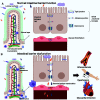Intestinal barrier dysfunction as a therapeutic target for cardiovascular disease
- PMID: 32986965
- PMCID: PMC7792706
- DOI: 10.1152/ajpheart.00612.2020
Intestinal barrier dysfunction as a therapeutic target for cardiovascular disease
Abstract
The gut microbiome and intestinal dysfunction have emerged as potential contributors to the development of cardiovascular disease (CVD). Alterations in gut microbiome are well documented in hypertension, atherosclerosis, and heart failure and have been investigated as a therapeutic target. However, a perhaps underappreciated but related role for intestinal barrier function has become evident. Increased intestinal permeability is observed in patients and mouse models of CVD. This increased intestinal permeability can enhance systemic inflammation, alter gut immune function, and has been demonstrated as predictive of adverse cardiovascular outcomes. The goal of this review is to examine the evidence supporting a role for intestinal barrier function in cardiovascular disease and its prospect as a novel therapeutic target. We outline key studies that have investigated intestinal permeability in hypertension, coronary artery disease, atherosclerosis, heart failure, and myocardial infarction. We highlight the central mechanisms involved in the breakdown of barrier function and look at emerging evidence for restored barrier function as a contributor to promising treatment strategies such as short chain fatty acid, probiotic, and renin angiotensin system-targeted therapeutics. Recent studies of more selective targeting of the intestinal barrier to improve disease outcomes are also examined. We suggest that although current data supporting a contribution of intestinal permeability to CVD pathogenesis are largely associative, it appears to be a promising avenue for further investigation. Additional studies of the mechanisms of barrier restoration in CVD and testing of intestinal barrier-targeted compounds will be required to confirm their potential as a new class of CVD therapeutic.
Keywords: atherosclerosis; cardiovascular disease; gut microbiome; hypertension; intestinal permeability.
Conflict of interest statement
No conflicts of interest, financial or otherwise, are declared by the authors.
Figures

References
-
- Ahmari N, Santisteban MM, Miller DR, Geis NM, Larkin R, Redler T, Denson H, Khoshbouei H, Baekey DM, Raizada MK, Zubcevic J. Elevated bone marrow sympathetic drive precedes systemic inflammation in angiotensin II hypertension. Am J Physiol Heart Circ Physiol 317: H279–H289, 2019. doi:10.1152/ajpheart.00510.2018. - DOI - PMC - PubMed
-
- Arakawa K, Ishigami T, Nakai-Sugiyama M, Chen L, Doi H, Kino T, Minegishi S, Saigoh-Teranaka S, Sasaki-Nakashima R, Hibi K, Kimura K, Tamura K. Lubiprostone as a potential therapeutic agent to improve intestinal permeability and prevent the development of atherosclerosis in apolipoprotein E-deficient mice. PLoS One 14: e0218096, 2019. doi:10.1371/journal.pone.0218096. - DOI - PMC - PubMed
-
- Arseneault-Bréard J, Rondeau I, Gilbert K, Girard SA, Tompkins TA, Godbout R, Rousseau G. Combination of Lactobacillus helveticus R0052 and Bifidobacterium longum R0175 reduces post-myocardial infarction depression symptoms and restores intestinal permeability in a rat model. Br J Nutr 107: 1793–1799, 2012. doi:10.1017/S0007114511005137. - DOI - PubMed
Publication types
MeSH terms
Substances
Grants and funding
LinkOut - more resources
Full Text Sources

